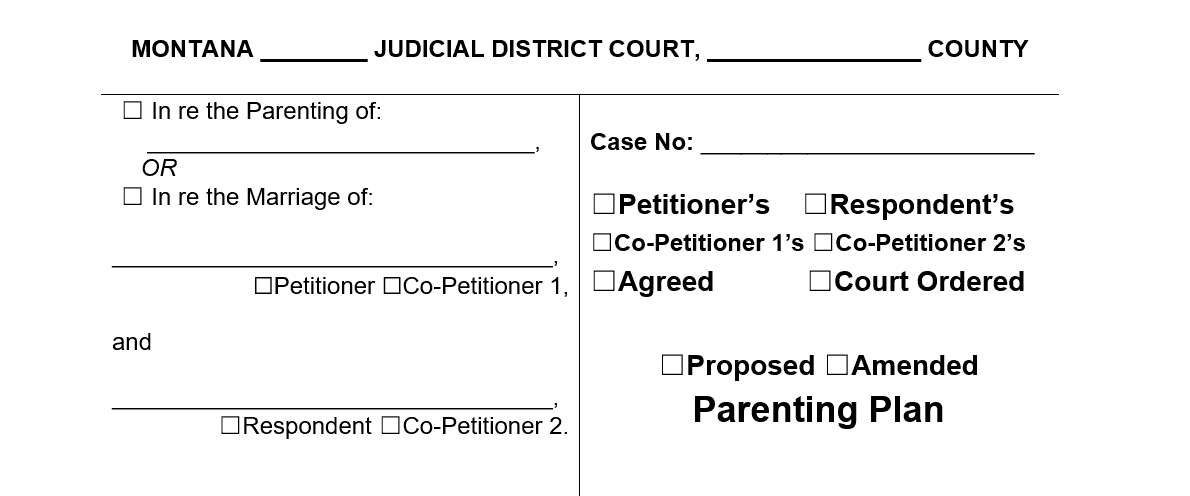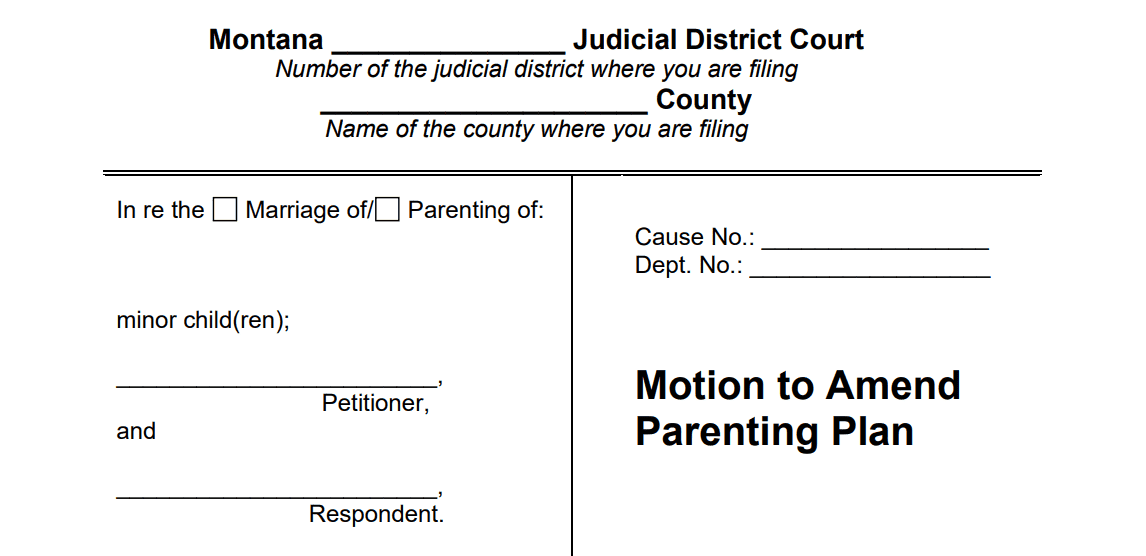Making a Montana Parenting Plan (Custody Agreement)
In Montana, parents must submit a parenting plan when they start a dissolution or parenting case. Parents can each submit their own plan for the judge to consider, or submit an agreed plan together.
The plan sets rules for how parents will raise their child after they separate. It becomes legally enforceable once signed by a judge.
Try this with Custody X Change.
Parenting plan templates
Montana has its own parenting plan template.

You may choose another format, like the Custody X Change parenting plan template. It helps you create a detailed parenting plan with more than 100 provisions to choose from and the option to create your own.
 You can customize this with Custody X Change.
You can customize this with Custody X Change.
If you prefer, you could use both. Start with the court's template, then use Custody X Change to cover additional topics.
What to include in a parenting plan
Your parenting plan must cover your residential schedule, decision-making, child support and information sharing.
Some counties have local parenting plan guidelines that require you to cover more topics. Consult with a lawyer or check your nearest Court Help Connect Workstation to find out your county's rules.
Residential schedule
A residential schedule lays out exactly when the child will be with each parent day-to-day. A holiday schedule is optional.
Parents often share parenting time, meaning they each have the child at least 110 days a year. "The child may still have one home base based on parents' work schedules," said Attorney Amy Lord of Missoula. The home base determines where the child goes to school.
When the time split is less equal, the parent who has more time is the residential parent, while the other parent is the nonresidential parent.
The nonresidential parent has regular visits (also called contact). Supervised visitation is an option if it's unsafe for the child to be alone with the parent. Visits can happen at a supervised visitation center, or a family member or friend can supervise. Centers have limited availability, so the parent might only get a few hours of visitation per week.
You must include a statement that parents will give written notice of relocation at least 30 days before a move if it will require changes to the schedule. This applies even if a parent is not moving with the child.
Decision-making
Explain how you will handle making major decisions about your child's education, health care and more.
Parents usually have equal say in major decisions about their child. They can assign another person to be the "tiebreaker" or go to mediation when they can't agree. They can also split up decisions. For example, one parent might pick the child's extracurriculars, while the other makes nonemergency medical decisions.
In rare cases, one parent is the sole decision-maker.
Parents can make day-to-day decisions and emergency medical decisions when the child is with them.
Child support
Child support ensures both parents give financial support to the child.
Include the support amount in your parenting plan. You might go with the guideline amount determined by the child support worksheet or agree to a different amount.
"There are times that parties make contracts that deviate from the guidelines," said Attorney Lord, "but ultimately, the amount must be enough to meet your child's needs."
Attach a worksheet and financial affidavit to your plan, even if you agree.
Information sharing
Parents have a right to access their child's school, health and other records. They must also keep each other up-to-date on their personal information, like their address, phone number and employer.
Include how you'll handle exchanging this information, like how soon it must be provided after a request.
Optional parenting plan terms
Adding more terms to your plan can help simplify co-parenting.
- Communication: Specify how you will discuss child-related matters. Will you meet in person or communicate via text, email or a co-parenting communication app?
- Transitions: Include how you will transfer the child from one parent's care to the other's. Can you bring the child to your co-parent's door? Will transitions happen at a neutral location, like a grocery store parking lot? Do you need supervised transitions?
- Travel: How will you handle traveling with the child? Explain how much notice parents must give, whether they must provide an itinerary, etc.
- Child-rearing: Make clear guidelines for everything from discipline to the child's diet. One key element is enforcing punishments in both homes, like the loss of cell phone or video game privileges.
How to modify a parenting plan
You can modify your parenting plan by filing an agreement with the court or asking a judge to decide for you.
The court offers instructions and forms for changing a parenting plan without the other parent's agreement. You file a motion with the court, along with your proposed parenting plan.

Some parents go to mediation to negotiate a new plan, or they negotiate on their own. They still need to file their agreement with the court.
Attorney Lord noted that it is possible to plan ahead for changes. "In some circumstances, when a parenting plan is established … we may build incremental changes based on that child's growth and development." This is often called a step-up parenting plan. It's a good option for infants, young children and children who haven't spent much time with the nonresidential parent.
The easiest way to make a parenting plan
When you're writing a parenting plan, it's critical you use airtight language that leaves no room for interpretation.
If you hire a lawyer, they'll write up the plan and ensure it meets the court's requirements.
If you write your own plan, use technology to take guesswork out of the equation. The parenting plan template in the Custody X Change online app walks you through each step.
 You can customize this with Custody X Change.
You can customize this with Custody X Change.
The result is a professional document that demonstrates your competence as a parent from the first glance.
The easiest and most reliable way to make a parenting plan is with Custody X Change.
